A rebel, between past and future
... But his are thoughts of freedom, memories, acknowledgements, and reflections. He wants to talk about the past, the future, everything. Maybe even the Universe.
Aldo is like this, every time you meet him he manages to sweep you away. He involves you. A retrospective on Aldo will be held in a few days in Lucca, a very important first in Italy. I contacted him to get his impressions on his return to his origins, the city where he spent his infancy and adolescence. I try to grasp his feelings, emotions and above all his recollections. It is like an overflowing river. It’s impossible to embank him, you follow him and you become a stone being slammed from one bank to the other.
And yet there is something more profound that goes beyond his way of communicating, his American being but also his indissoluble ties to Italy. His artistic and human path is a burning fire of constant rebellion. He’s a man ready to feel - not just artistically - the responsibility to contest those that which others know only to accept.
“My goal is the masses; I look for simultaneity...for me humanity is sharing, giving of my personal experiences to others. One might say, ‘I own a Van Gogh,’ but I’d like to also say that even those who have nothing, share similar experiences. The same courage, the same tormented heart, the same human concept that anyone else may share.”
His has been a life linked to four cities: Syracuse, Lucca, New York and Cambridge. Son of a Brazilian father and an Italian mother, he was born in Syracuse, New York in 1930, and at 18 months he was taken to Lucca, where he began his artistic studies, but war interrupted his life. He was close to death at least two times: during the bombing of Lucca and soon after in the fields when the S.S. arrived.
In 1945 he returned to Syracuse where he attended university. In 1959 he moved to the Lower East Side of Manhattan, organized an underground movement called “Group Center,” and became the leader of a group of counter-culture artists. He opened the first experimental film theatre, the Gate Theatre, and with German artist Otto Piene, the Black Gate Theatre for live multimedia performances. At the beginning of the 60’s he began “the Black Film Series” and “Black TV” (now at the Museum of Modern Art), which won at the Oberhausen Festival. Since 1974, Aldo has been a Fellow at CAVS at MIT.
Aldo’s personality is multifaceted. He is an intense writer of prose and poetry. The abrasive witness and peace activist of our times tells me that in the past few years he has dedicated more time to his writing activities as an artistic outlet. Among his latest accomplishments was the Exhibit in Berlin No Art! Show and his digital film LISTEN, which won the Howl Festival 2004 in New York, the New England Experimental Film Festival, and the Syracuse International Film Festival.
Aldo is to some an agitating figure of the 60s and 70s, yet to others, a soothsayer. He puts forth political and social themes in his art: often-uncomfortable themes spanning from the assassination of Bobby Kennedy, to black youth, to the Vietnam War, to Italian-American issues, and civil rights.
He has no brakes. He explores new technologies and makes experimental videos. He works directly on film with chemical agents and inks, he scratches them, and inserts commercial footage. “I used media as a social reaction against those who didn’t consider media as an art form. No gallery or museum in New York in 1967 would have given importance to a low quality VHS tape.”
When Tambellini picked up an amateur video camera, he intuitively realized he had a cheap, immediate, powerful tool in his hands. And everywhere in his films was the color black. “Black to me is like a beginning - a beginning of what it wants to be rather than what it does not want to be. I don’t mean black as a tradition or non-tradition in painting, nor as having anything to do with pigment, nor as an opposition to color. As I am working and exploring black in different dimensions, I’m definitely more and more convinced that black is actually the beginning of everything. Black gets rid of historical definitions. Black is a state of being, both blind and more aware. Black is oneness with birth. Black is within totality, the oneness of all. Black is the expansion of consciousness in all directions. Blackness is the beginning of the re-sensitizing of human beings. I strongly believe in the words ‘black power’ as a powerful message, for it destroys the old notion of western man, and by destroying that notion it also destroys traditional concepts of art.”
Memories of war permeate his whole life, personal and artistic - and even here, “black” appears….”The jeeps came down from the mountains; there were black Americans who came to liberate us. Only their commanding officers were white. Maybe this is the reason why I am one of the few Italian-Americans involved with blacks.”
Curious and immersed in the future, but always holding onto a thread of the past, Tambellini narrates his memories as events as though they’ve just happened. Lucca unleashes on a non-stop emotional trip through his memories. Events of thirty or sixty years ago come to life. Memories of the art school where he made a fresco with images of the city. Memories of his military service and the first protests in which he took part. Memories of his mother, who was destroyed psychologically by the war, becoming more distant and fragile, to whom Aldo says he owes his artistic beginnings. Memories of that brother so different from him who used to attended fascist meetings. “I used to refuse to go, I was a lively child, I was only calm when I used to draw or paint.”
Proud of his Italian Culture, Aldo talks about how critical his foundation was, steeped in the classics, which he brought with him to America. “Dante was critical in my formation.” But with anger he insists that the media overshadows the image of the Italian-American. “When I returned to the United States I represented “Art” and the Italian culture to many, but now, however, it’s not the same. Italian-Americans are best known for their money, pizza and spaghetti, but never for their culture.”
“I respect people who are involved and militant, not those who think that nothing will ever change. Culture is important in keeping a connection with one’s roots, but Italian-Americans have not given serious consideration to this aspect, I must say, and no Italian-American has ever helped my art.”
“I am one of the oldest, very few of us are left”...and then more memories and comments. Since his arrival in Syracuse, his works have dealt more with blacks, and with world conflict still fresh in his mind, he captures the desperation in poor neighborhoods, where he finds yet another war - one on poverty. And this work becomes his door to the academy. “I went to the Museum of Fine Arts and I showed them my paintings. I was 17 years old and they told me ‘you should be teaching here.’ I became a teacher with my broken English. It was my first job. Then someone spoke to me about a group of artists who sublet a loft on Salina Street called Vedet. They were all much older than I was, they used to go there to paint, and they accepted me among them. They were modern. I knew little then of Modern Art, like De Chirico and Boccioni, for example, because in Italy, reproductions of their works appeared in literature books. Marinetti was the Minister of Culture then.
It’s now 2007 and his works will return to Italy thanks to the interest of a young researcher, Nicola Borelli and not because of a politician (the Minister of Culture). Moved by Tambellini’s work, and above all by the fact that Italy has known little of his work, the student of cinema has worked so lavishly to bring a consciousness of an artistic career which may have developed far away but, in a certain sense, still belongs to Italy. The program in Lucca is well articulated, the details of which may be found on the Lucca Film Festival (September 28-October 6) website http://www.vistanova.it.
A question comes to mind: how much time must pass before Italians and Italian-Americans become conscious of (and begin to recognize) such important cultural phenomena as that of the creative works of Aldo Tambellini?





































i-Italy
Facebook
Google+
This work may not be reproduced, in whole or in part, without prior written permission.
Questo lavoro non può essere riprodotto, in tutto o in parte, senza permesso scritto.